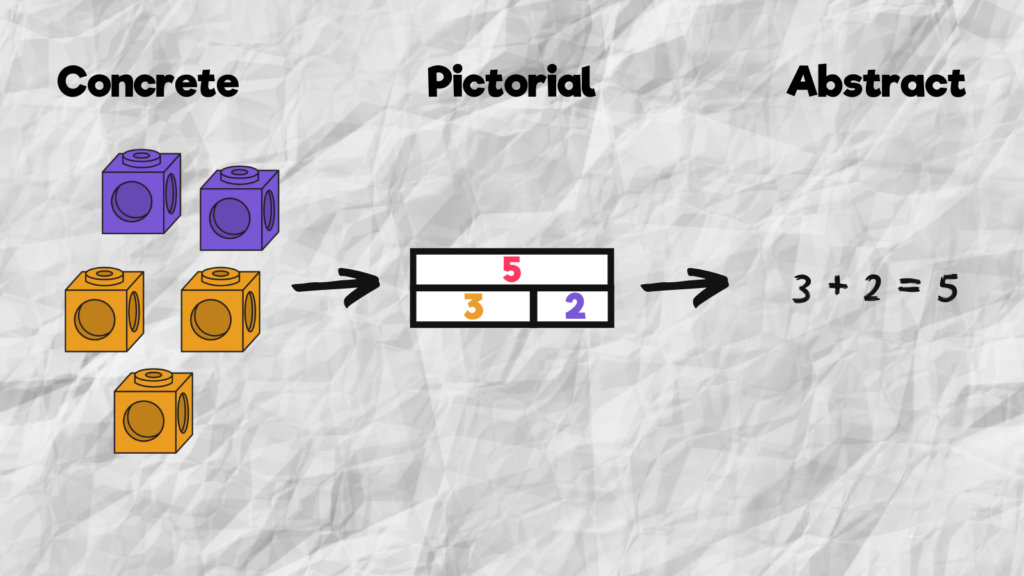
The Role of Concrete–Pictorial–Abstract (CPA) Method to teach math concepts
Teaching mathematics to children with special needs or learning difficulties requires more than just numbers and symbols; it needs meaning, connection, and hands-on experience. The Concrete–Pictorial–Abstract (CPA) Method is one of the most effective approaches in special education because it helps children truly understand math concepts, not just memorize them.
Let’s explore how the CPA approach transforms math learning for children with diverse needs.
🌟 What Is the CPA Method?
The Concrete–Pictorial–Abstract (CPA) approach is a step-by-step teaching strategy that moves from hands-on learning to visual understanding and finally to symbolic representation.
-
Concrete Stage:
-
Children use real objects or manipulatives (e.g., blocks, beads, counters, coins) to explore math ideas.
-
Example: To learn “2 + 3,” the child physically counts and combines two red cubes and three yellow cubes to see there are five in total.
-
This stage makes math tangible and builds conceptual understanding.
-
-
Pictorial Stage:
-
Children use pictures, drawings, or visual models to represent what they did with objects.
-
Example: After using cubes, the child draws two red circles and three yellow circles.
-
This stage bridges the gap between the physical and the abstract world.
-
-
Abstract Stage:
-
Finally, children use numbers and symbols (e.g., 2 + 3 = 5) to represent the concept they’ve already understood concretely and visually.
-
This stage focuses on reasoning, fluency, and applying learned concepts.
-
🎯 Why the CPA Method Works So Well in Special Education
1. Builds Conceptual Understanding Before Memorization
Many children with learning difficulties struggle with rote learning. CPA ensures they understand why a math process works before moving to abstract symbols. This understanding builds long-term retention and confidence.
2. Supports Multi-Sensory Learning
The approach naturally integrates visual, tactile, and kinesthetic inputs - crucial for learners with dyslexia, ADHD, or dyscalculia. Children see, touch, move, and visualize numbers, making math a sensory-rich experience.
3. Bridges the Gap Between Concrete and Abstract Thinking
Children with special needs often find it hard to move from physical to symbolic learning. The pictorial stage serves as a vital bridge, making the transition smoother and less intimidating.
4. Encourages Active Participation
When children manipulate objects and draw their ideas, they stay actively engaged. This hands-on involvement increases focus, motivation, and confidence during learning.
5. Makes Error Correction Easy
In the concrete stage, errors become visible and easily correctable.
For example, if a child miscounts blocks, they can physically see and fix it—a supportive way to learn without frustration.
🧠 Practical Examples of CPA in Action
Concept |
Concrete |
Pictorial |
Abstract |
Addition (2 + 3) |
Use 2 red cubes and 3 blue cubes; count all to get 5. |
Draw two red circles and three blue circles; total = 5. |
Write 2 + 3 = 5 |
Subtraction (5 - 2) |
Start with 5 blocks, remove 2, count what’s left. |
Draw 5 stars, cross out 2. |
Write 5 - 2 = 3 |
Place Value |
Use base-ten blocks to show tens and ones. |
Draw tens rods and ones dots. |
Write 34 = 3 tens + 4 ones |
Fractions (½, ¼) |
Cut a paper circle into equal parts. |
Draw a circle divided into halves or quarters. |
Write ½, ¼ |
🪄 Tips for parents, Teachers and therapist:
-
Start only with the concrete stage until the child shows understanding.
-
Move slowly from one stage to the next; don’t rush to abstract.
-
Use everyday objects (buttons, coins, spoons) to make learning relatable.
-
Reinforce vocabulary (e.g., add, take away, more than, less than).
-
Celebrate small achievements to boost confidence.
